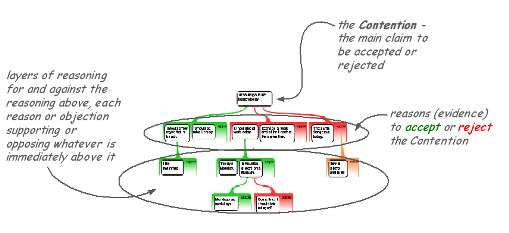What is argument mapping?
Argument maps are box-and-line diagrams that lay out visually reasoning and evidence for and against a statement or claim. A good map clarifies and organizes thinking by showing the logical relationships between thoughts that are expressed simply and precisely.
Argument maps are driven by asking, ‘Should I believe that? Why, or why not?’.
You can produce two kinds of argument maps in Rationale:
- Reasoning maps, which lay out arguments in a quick, intuitive way
- Advanced Reasoning (or Analytic) maps, which enable a more careful and rigorous analysis of an argument.
How does Argument Mapping differ from other kinds of mapping?
Different kinds of map are defined by the nature of the relationships they depict – what the boxes and lines mean. What kind of map something is depends on:
- what goes in the boxes; and
- what the connecting lines indicate.
Argument Maps show only evidential (inferential) relationships between claims. In Argument Maps, the lines mean something very specific: that something is a reason to believe or a reason not to believe something else. Argument maps are driven by the question, ‘Why should I believe that?’. Any map driven by that question is an Argument Map.
Why would I map?
Argument maps
- help you organise and navigate around complex information
- clarify reasoning
- communicate reasoning quickly and effectively
- support critical thinking

